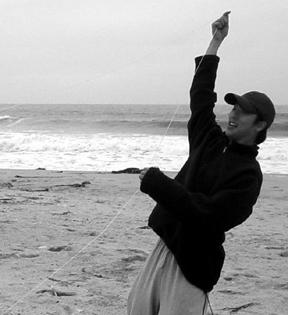|
ˇˇ
|
|
|
Name: Sangbae Kim
In 2003 spring,
ME310 class went a picnic to Half moon bay and Prof. Cutkosky invented a sort of miniature design competition.
The rule is that team who makes the highest structure wins
using material in the beach and scissors and thread. I
asked "Would a kite be considered as a 'Structure'?" We
built a kite out of feathers of seagull and plastic bag and
our team won the game..
Sangbae is...... Sangbae Kim received his B.S. degree in Mechanical Engineering from Yonsei University in Seoul, Korea in 2001. He joined a startup company, Solutionix(solutionix.com), in Seoul, where developed mechanical systems for 3-D optical scanners. In 2002 he moved to California where he received his M.S. degree in Mechanical Engineering from Stanford University, specializing in mechatronic systems design. He is currently completing his Ph.D. in the Biomimetic Robotics Laboratory at the Stanford Center for Design Research. At Stanford, Kim has been the principal designer of several bio-inspired legged robots including iSprawl, a cockroach-inspired hexapod that runs at up to 15 body-lengths/second over rough terrain, Spinybot, an arthropod-inspired robot that climbs vertical outdoor surfaces such as stucco and concrete and Stickybot, a gecko-inspired robot that employs the first synthetic directional dry adhesive pads to climb smooth vertical surfaces such as windows. The design principles behind these robots are described in several publications and three pending patents for which Kim is the primary inventor. A video of Spinybot received the ˇ°Best Videoˇ± award from among 65 submissions at the 2006 IEEE International Conference on Robotics and Automation. His latest artwork, Stickybot was one of the BEST INVENTION of 2006 at TIME magazine and his paper about Stickybot received "Best Student Paper Award" and Finalist of "Best Conference Award" at IEEE international conference on Robotics and Automation April 2007 in Rome. His invention of directional adhesion is Sangbae KimˇŻs research interests include the design and modeling of compliant under-actuated mechanisms to improve the performance and simplify the control of robots. He is an expert in multi-material rapid-prototyping methods for bio-inspired robotic systems. ˇˇ Publication Kim, S., Clark, J.E. and Cutkosky, M.R.,"iSprawl: Design and Tuning for High-speed Autonomous Open-loop Running" International Journal of Robotics Research. Kim, S., Clark, J.E. and Cutkosky, M.R., ˇ°Isprawl : Autonomy, and the Effects of Power Transmission,ˇ± Proc. CLAWAR, Madrid, Spain, Sept. 22-24, 2004. (See also the IndependentSprawl page.) Kim, S., Asbeck, A., Provancher, W., and
Cutkosky, M.R.,
ˇ°SpinybotII: Climbing Hard Walls with Compliant
Microspines,ˇ±
IEEE
ICAR, Seattle, WA, July, 18-20, 2005. Kim, S., Spenko, M., Trujillo, S. Heyneman, B., Santos, D., Cutkosky, M. R. "Smooth Vertical Surface Climbing with Directional Adhesion" IEEE a special issue of transactions on Bio-Robotics Santos, D., Kim, S., Spenko, M., Parness, A., Cutkosky, M.R., "Directional Adhesive Structures for Controlled Climbing on Smooth Vertical Surfaces" ICRA Rome, Italy, 10-14 April 2007, 1262-1267
Asbeck, A.T., Kim, S., McClung, A., Parness, A.,
and Cutkosky, M.R.,
Climbing Walls with Microspines," , IEEE
ICRA, May 2006, Orlando, Fla. (Short
paper to go with
IEEE ICRA 2006 video. -- paper describes
adaptation of the
SpinyBot technology to the
RisePlatform.) -- Won
the best video at ICRA 2006
Asbeck, A., Kim, S., Provancher, W.R., Cutkosky, M.R. and Lanzetta, M., ˇ°Scaling Hard Surfaces With Microspine Arrays,ˇ± Robotics: Science and Systems, MIT, June 8-10, 2005. ˇˇ ˇˇ |
|
